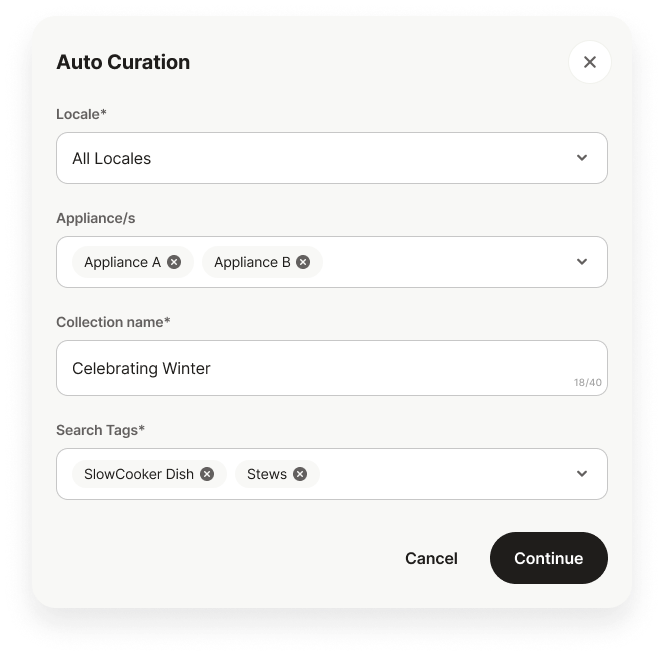Case Study: CMS REcipe Home Feed
Overview
As part of our Smart Cooking Platform, we work with global appliance partners who deliver recipe content through their branded apps. The CMS Home Feed is a tool we built to help these partners manage what appears on their app’s home screen, for example, featured recipes, carousels, and seasonal promotions.
“Our differentiator is the amount of recipes that we have. We constantly use that as a sell leading point for the app and for our appliances. It’s hard to showcase that right now.”
The Probelm
FOr Partners
Partners needed an easier, faster way to manage and preview their content. They have no direct way to control their app's home feed. Updates have to go through our internal teams using static JSON files—a manual and time-consuming process. Even small changes, like fixing a typo, could take weeks to go live. This bottleneck caused frustration and slowed down time-sensitive campaigns.
HMW enable partners to be self-serving in controlling their home feed content—so they can learn and improve recipe engagement?
For Fresco
Internally, the JSON-based process created a massive operational burden. Updating home feed content for partners takes an average of 2.5 hours of work from 3 different team members per request, and could only be done once a week. This approach was not scalable as the number of partners grew.
HMW free up Fresco employees from manual JSON work so they can focus on higher-value initiatives?
For Home Cooks
Home cooks weren’t seeing fresh, engaging recipe content as often as they should. Partners were only able to update the home feed once a week due to the time and effort required to prepare JSON files and go through Fresco’s internal process. This meant curated feeds rarely aligned with seasonal moments or trends, leading to stale app experiences.
HMW improve cooks to see fresh and high quality recipes to cook that are suited to their appliances
External Partner Workflow for Home Feed APP Management
Partner JSON file set up
Challenges
Locale and appliance Complexity
Partners operate across multiple locales and languages, and each recipe must be compatible with specific appliances and locales. This added layers of logic and validation that our CMS needed to handle dynamically:
Collection duplication to another locale required checking if each recipe had a translated version available.
Appliance logic required validating that each recipe met the compatibility rules for the selected collection’s appliances.
Any issues in these areas needed clear, user-friendly resolution flows.
My Role
As the lead designer, I was deeply involved from discovery through to delivery. My responsibilities included:
Interviewing partners and internal teams to understand current workflows, pain points, and what an ideal solution might look like
Collaborating with PM and engineering to define and prioritise an MVP then clearly breaking down features into P1, P2, and future phases to ensure we could deliver value quickly while building toward a scalable long-term solution
Designing end-to-end UX flows, wireframes, and high-fidelity UI for web
Solve for recipe appliance and locale complexity, making sure the solution could accommodate multiple partners, languages, and regions from day one
Leading feedback cycles, using those insights to continuously iterate on the experience
Working cross-functionally to ensure the solution was feasible, aligned with platform capabilities, and met the needs of both partners and internal teams
Wireframe Logic
Different Curation Logics
User flows
Home Feed - MVP, P1, P2…
Our iterative approach still continues but to-date I have designed solutions that include:
A clear workflow for partners to create and manage recipe collections across multiple locales and appliances.
Smart validation and conflict handling, especially when duplicating content across locales. If a recipe wasn’t translated or didn’t match appliance requirements, we offered actionable options (e.g., auto-translate, modify, or remove).
Mobile APP previews to simulate how home feed collections would appear for real users based on locale and connected appliance configuration.
Streamline large-scale feed management: Drag-and-drop ordering, advanced search, filtering, sort and duplication to other locales.
Real-time publishing controls that let partners update their feeds whenever they wanted — daily if needed — without developer support.
MVP - Partners created collections by manually selecting recipes to be in each one
P3 + Partners can build a single collection that will populate across multiple locales and appliances using search tags. The Home Feeds would pull in the relevant recipes through a set of returned results, filtered by locale and appliance(s).
Impact
This tool fundamentally changed the way our partners work:
Partners now have full autonomy and no longer rely on our team for operational changes. They went from bi-weekly updates to instant edits.
Since launch, the internal operational effort has gone from 3.5 hours per partner per week to zero.
The system is scalable across new languages, locales, and appliance types, unlocking global growth which was a key factor for our partners.
Engagement metrics improved — home feed recipe interaction rose by 7 percentage points after launch, and partners have requested only minor enhancements, not fixes.
Fresher and more relevant themed content is being delivered to home cooks on a regular bases.










Outcome
“This feature is a game changer! Very happy that recipes that are not yet created in a new locale will be forked by the system
It was very straightforward, used it without needing to watch a Loom video. I clearly understood the two types of validation windows for Forking Recipes and Recipes that have an appliance incompatibility.”
This project required me to deeply understand complex technical constraints, localisation, user behaviour, and operational goals.
I collaborated closely with engineering, product, and our partner content management teams to ensure the tool was both powerful and usable — and ultimately delivered a solution that empowers partners while improving the end-user experience






